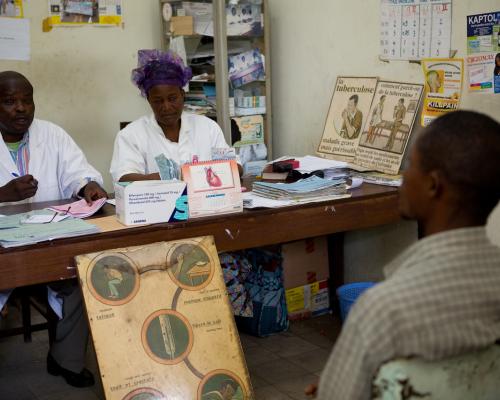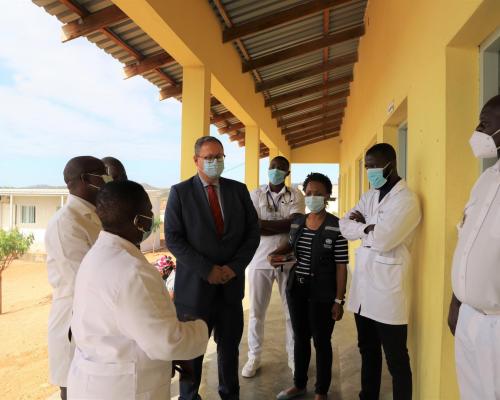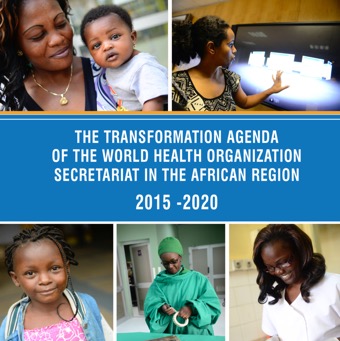Uganda deploys national Emergency Medical Team to support mpox response
Kampala. The World Health Organization (WHO) with funding from the United States Agency for International Development (USAID) has supported Uganda’s Ministry of Health (MoH) to deploy the national Emergency Medical Team (nEMT) in the mpox outbreak response.
Uganda declared an outbreak of mpox on 24 July 2024, following confirmation of two cases in Kasese District. The outbreak has progressed since the declaration to affect over 70 districts with more than 2,000 cases reported across the country.
In September 2024, the Ministry of Health categorized Nakasongola district as being most affected, with high transmission rates, largely amongst fisherfolk and sex workers. The case load was higher than the existing local capacity, with few health workers trained on mpox case management. Further, the district lacked a functional isolation unit where cases could be safely managed. The challenges in isolating cases resulted in confirmed and probable cases remaining in the community, posing continued risk of community transmissions.
In response, MoH requested for the deployment of the nEMT to boost the district outbreak response. The team supported the case management pillar by implementing outbreak control measures to reduce morbidity and mortality associated with the outbreak. This included providing direct clinical care according to national mpox case management guidelines, strengthening referral systems to evacuate new cases from the community promptly, referring severe cases for higher level care and building capacity of the local teams through training and mentorship.
“WHO supported the deployment of skilled health workers from Ministry of Health to support patient care, but also strengthen district capacity to effectively and appropriately respond to the mpox outbreak,” said Dr Agaba Byamukama, the Nakasongola District Health Officer.
In the first week of deployment, the team set up a field isolation unit at Lwampanga Health centre III, near the epicentre, to support patient isolation without affecting continuity of essential health services. This was a 24-bed capacity unit with designated patient and staff areas with water sanitation and hygiene facilities.
“This was the first time a team consisting of local health workers constructed and functionalized a field isolation unit in Uganda during an outbreak,” said Dr Annet Alenyo Ngabirano, the WHO Uganda Case Management Officer.
To support referrals, the nEMT guided the district to operationalize a 10-bed isolation unit at Nakasongola Health centre IV to manage complicated cases. The team also trained and mentored district health workers in mpox clinical care and infection prevention and control. Over 90 health workers were trained including public, private, and armed forces medical teams.
Furthermore, the nEMT provided mental health and psycho-social services to health workers, patients and their communities including affected schools. Mentorship and training were extended to existing social support structures such as the district social workforce, and the Uganda police force, to ensure sustainable support to survivors’ resettlement.
Between October and November 2024, the team managed 107 mpox patients (39 confirmed and 68 suspect cases) in Nakasongola district. The mpox mortality rate in the district during the period of the nEMT deployment was zero, despite mortalities in other districts. The local team has maintained the high standard of care following their mentorship, ensuring no mortality to date.
The national mpox mortality rate as of 13 January 2025 is 0.60%. Entebbe Regional Referral Hospital Isolation unit has contributed 80% of all mortalities (8 out of the 10 mortalities), largely amongst high-risk populations such as HIV patients and children. Several factors have been considered to contribute to this high mortality including high patient volumes with a low health worker-to-patient ratio, thereby impacting delivery of quality clinical care. Further, there is no intensive care unit set up to support critically sick patients.
On 8 January 2025, the Ministry of Health again requested WHO to support the deployment of nine nEMT members as a stop gap measure to boost the local capacity and reverse the mortality trend in the Entebbe hospital isolation unit. As of 13 January 2025, the team had reduced the bed occupancy from 198% to 113% with zero mortalities reported. The deployment to Entebbe is expected to last three weeks.
“Public health emergencies can quickly overwhelm the local health system necessitating additional support. Fortunately, national EMTs understand the local context and are readily deployable to support affected communities,” said Dr Kasonde Mwinga, the WHO Representative to Uganda.
Uganda currently has 149 nEMT members, readily available to support the health system in providing direct clinical care to communities affected by disasters and public health emergencies. The nEMT concept dates to December 2021 during the COVID-19 pandemic. At the time, MoH, with support from WHO, hosted the first regional training for nEMT members to support the COVID-19 response. MoH continued to build the team through additional trainings and drills supported by WHO with funding from partners like the European Union Humanitarian Aid Agency (DG ECHO), the Robert Koch Institute and Malteser International among others.
In July 2024, MoH approved the nEMT roadmap that will provide guidance for further development of the EMT initiative in Uganda. The global EMT initiative aims to improve the timeliness and quality of health services provided by national and international EMTs and enhance the capacity of national health systems to lead the activation and coordination of emergency response in the immediate aftermath of a disaster, outbreak, and other emergencies.


